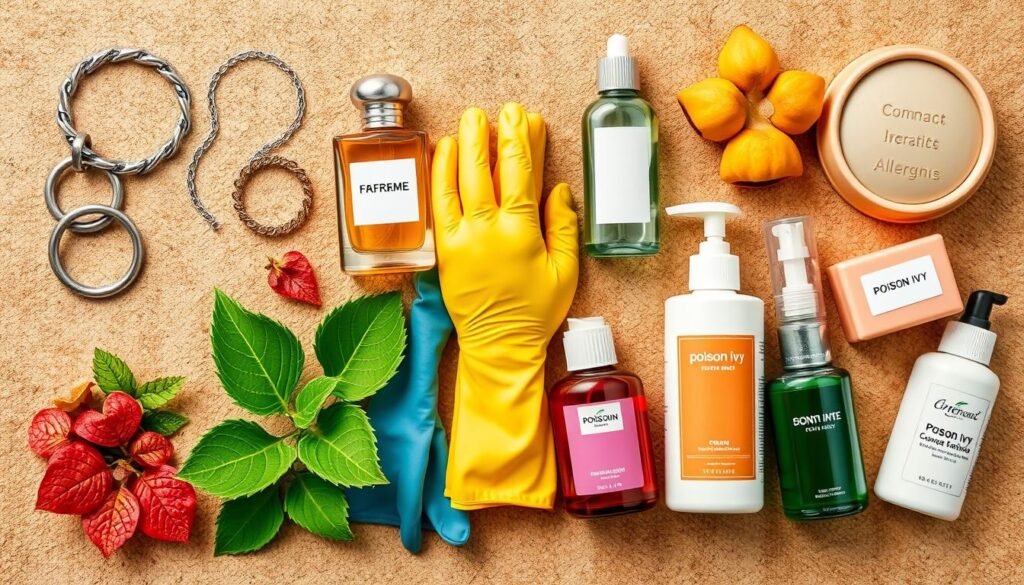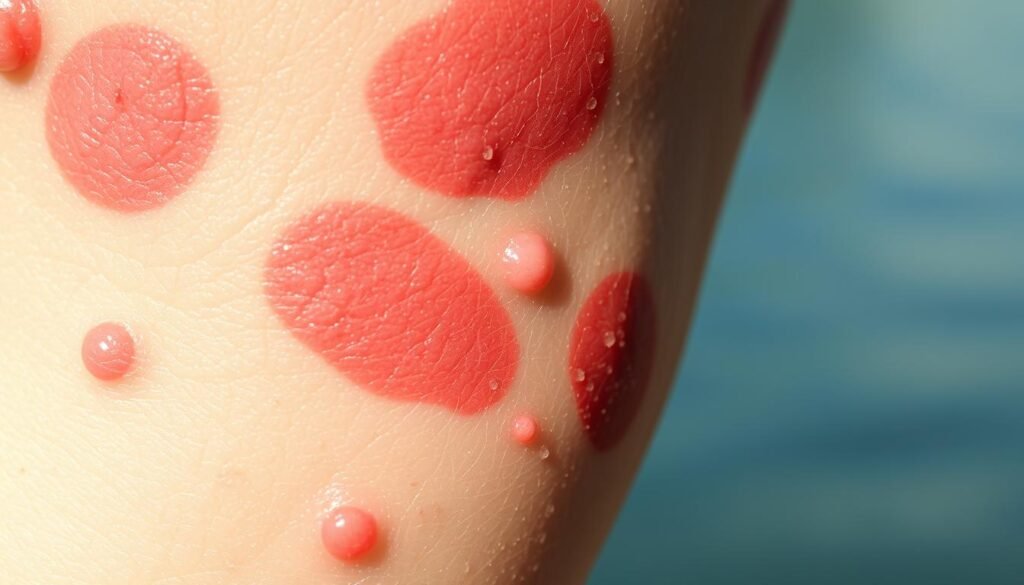Irritant contact dermatitis impacts lots of people each year. It happens when your skin meets substances that bother it or cause allergies. Knowing what triggers contact dermatitis helps in avoiding and treating it, which is key for healthy skin.
Many things can cause contact dermatitis, from common household products to allergens in personal care items. Knowing these causes helps reduce skin issues. This article looks at various triggers, symptoms, and how to steer clear of this skin problem. For a deeper understanding of contact dermatitis causes, read more here.
Key Takeaways
- Irritant contact dermatitis is the most common type.
- Common irritants include chemicals, gardening products, and certain personal care items.
- Allergic reactions can develop suddenly or progressively over time.
- Contact dermatitis frequently occurs on exposed areas like hands and face.
- Identifying triggers is crucial for effective management and prevention.
- Symptoms may last for weeks even after exposure to the irritant has ceased.
What is Contact Dermatitis?
Contact dermatitis is a skin inflammation. It happens when you touch certain substances. These substances can irritate your skin or cause an allergic reaction. The skin gets red and uncomfortable, but it’s not contagious. Symptoms can show up quickly or take hours to appear. This condition can last from 2 to 4 weeks.
There are two main dermatitis types. The first type is irritant contact dermatitis. It’s the most common and happens when something breaks down the skin’s defense layer. Things like detergents and hair products are common irritants. The second type is allergic contact dermatitis. This occurs from an immune reaction to things like nickel and fragrances.
Knowing about contact dermatitis is key to managing it. Both types happen after repeated contact with certain substances. For kids, things like diapers can cause reactions. When symptoms show, it’s important to avoid whatever causes the reaction. Taking steps to protect the skin is also crucial.
| Dermatitis Type | Causes | Common Symptoms |
|---|---|---|
| Irritant Contact Dermatitis | Soaps, detergents, bleach, solvents | Redness, itching, burning sensation |
| Allergic Contact Dermatitis | Nickel, fragrances, poison ivy, medications | Swelling, blistering, skin scaling |
Understanding the Symptoms of Contact Dermatitis
Contact dermatitis shows up in many ways, different for everyone. It often starts with a dermatitis rash—red and itchy patches. These can swell, burn, or blister, making the skin uncomfortable.
In worst cases, these areas might crust over or ooze. That adds to the discomfort.
When symptoms appear varies a lot. For some, it’s within hours; for others, days later. The skin might also turn darker or become dry and cracked. Knowing these skin irritation signs helps manage and treat the condition effectively.
If you think you have contact dermatitis, recognizing these symptoms is key. It helps tell it apart from other skin conditions. It’s important to consider your own experiences and what triggers your symptoms.
| Symptoms | Description |
|---|---|
| Itchy Rash | Red, inflamed skin that itches intensely. |
| Swelling | Localized area may become puffy or inflamed. |
| Burning Sensation | Skin may feel warm and sensitive to touch. |
| Blisters | Fluid-filled bumps that can break open and ooze. |
| Crustiness | Dryness at the surface can lead to crust formation. |
| Hyperpigmentation | Skin discoloration can occur in healing areas. |
The Most Common Triggers of Contact Dermatitis
Contact dermatitis has two main kinds: irritant and allergic. Each has different causes and ways to handle them. Knowing what triggers these can help keep your skin healthy and improve your life.
Irritant Contact Dermatitis
Irritant contact dermatitis is very common. It happens when things like soaps or chemicals damage the skin. Water can also make it worse. Some common causes are:
- Soaps
- Detergents
- Bleach
- Cleaning agents
- Solvents
This dermatitis can cause burning, pain, and itching. It often affects hands, face, and neck. To prevent it, try to avoid irritants and wear gloves when you can.
Allergic Contact Dermatitis
Allergic contact dermatitis is caused by an immune reaction to allergens. It’s less common but can be serious. It can start suddenly or after being exposed for a long time. Some major allergens are:
- Nickel
- Fragrances
- Balsam of Peru
- Latex
- Raw fruits and vegetables
- Certain UV-activated chemicals
To manage it well, avoid allergens, especially at work. Using emollients regularly can help your skin heal in two to three weeks.
Common Contact Dermatitis Causes in Daily Life
Contact dermatitis is often linked to everyday things. Knowing what triggers it helps limit skin issues. Household items and personal care products are key culprits.
Household Products
Many home products can cause contact dermatitis. Cleaning agents, detergents, and air fresheners are common irritants. They include:
- Dish soap
- Surface cleaners
- Fabric softeners
- Disinfectants
These items may have harsh chemicals. They can weaken the skin’s defense over time. Learning about them helps people choose safer options.
Personal Care Items
Personal care items often lead to contact dermatitis. Ingredients in shampoos, lotions, soaps, and makeup can be problematic. Among them are:
- Perfumes
- Nail polish and removers
- Moisturizers with added scents
- Shampoo with sulfates
Those with sensitive skin might react even to mild allergens with time. It’s vital to recognize and adjust the use of such products. This helps keep skin healthy and reaction-free.
Contact Dermatitis Irritants to Avoid
Knowing what triggers contact dermatitis is key for skin health. Soaps and detergents are common culprits that can harm your skin. By avoiding them, you can lower your risk of skin problems.
Soaps and Detergents
Soaps and detergents can remove your skin’s natural oils. This can cause irritation. They are not good for people with sensitive skin. Understanding these irritants is important for keeping your skin safe.
Workplace Substances
Workplaces often have substances that can cause skin issues. The manufacturing, mining, and healthcare fields see a lot of these problems. Protective gear and education can cut down on skin issues.
| Common Irritants | Sources | Impact |
|---|---|---|
| Soaps | Household and personal care | Strips skin moisture, causing irritation |
| Detergents | Cleaning products | Can lead to inflammatory skin reactions |
| Solvents | Industrial cleaning | Most cases of irritant dermatitis are linked |
| Cutting fluids | Manufacturing | Common trigger in workers |
Common Contact Dermatitis Allergens
Contact dermatitis comes from various allergens. Some are more common than others. Knowing these allergens helps people stay away from them. It can lower the chance of skin problems.
Nickel and Other Metals
Nickel dermatitis is a top cause of allergic skin reactions. It’s often in jewelry and clothes buttons. Just a little nickel can irritate the skin a lot. Other metals like chromium and cobalt also trigger reactions. They’re in some tools and gadgets. Knowing if you’re sensitive to these metals is key to avoiding problems.
Plants and Fragrances
Plants are also big allergens. Poison ivy, poison oak, and mango sap cause allergic skin issues. Fragrances in products, like lotions and perfumes, are another big trigger. They’re the second most common allergen. Rubber latex in things like gloves and balloons also causes irritation. Knowing about these allergens helps make better choices.

How Contact Dermatitis Develops
Contact dermatitis starts when your skin reacts to irritants or allergens. There are two main types. Irritant contact dermatitis comes from direct contact with harmful substances. Allergic contact dermatitis is due to an immune reaction after repeated exposures to substances like nickel or rubber.
At first, your body does not show signs of an allergy. But with more exposure, even a tiny bit of allergen can cause symptoms. You might see itching, redness, and blisters. These can appear hours or even days later.
Preventing these reactions means knowing what triggers them. Common problems come from soaps, detergents, and some skincare products. Those with skin issues or exposed to certain chemicals are at greater risk. Spotting these triggers early and avoiding them can help stop severe reactions.
Contact Dermatitis Symptoms to Watch For
It’s key to know the signs of dermatitis symptoms to watch early on. Contact dermatitis shows up in a few main ways. Rashes that itch and bother you are a big sign. Knowing what to look for helps you deal with it fast.
Itchy Rashes
Itchy dermatitis is a big clue you might have contact dermatitis. Wanting to scratch all the time is common. But scratching too much can make things worse, like causing infections.
Blisters and Redness
Blisters are another sign of dermatitis. You may see red bumps that turn into wet blisters. They can hurt and make the skin feel hot. Try not to scratch them to avoid more problems.
Watch your skin closely. If you notice signs of infection or if the rash stays, get help from a doctor.

Effective Contact Dermatitis Treatment Options
Treatment for contact dermatitis seeks to ease symptoms and prevent flares. Choices range from simple store-bought remedies to advanced prescriptions. Knowing which treatment works best is crucial.
Over-the-Counter Remedies
For light cases, many opt for over-the-counter solutions. These include:
- Topical corticosteroids to lessen inflammation and calm irritated skin.
- Antihistamines to ease itching and increase comfort.
- Moisturizing lotions and creams to stop dryness and keep skin moist.
Using emollients regularly helps strengthen the skin’s defense, making it less sensitive to irritants.
Prescription Treatments
For tougher cases, doctors might prescribe stronger meds. These treatments include:
- Stronger corticosteroids for greater anti-inflammatory action.
- Immune-modulating creams, such as pimecrolimus and tacrolimus, for ongoing issues.
- Oral corticosteroids for widespread rashes over much of the body.
Talking to a healthcare provider is key for a tailored treatment plan. Dermatologists might suggest more advanced therapies like immunosuppressant therapy or phototherapy, depending on the case.
| Treatment Type | Description | Indications |
|---|---|---|
| Over-the-Counter Remedies | Easy-to-get treatments like creams, lotions, and antihistamines. | Mild to moderate contact dermatitis. |
| Prescription Medications | Stronger treatments from healthcare experts. | Severe or ongoing dermatitis. |
Best Practices for Avoiding Contact Dermatitis
Avoiding contact dermatitis starts by knowing what triggers bad skin reactions. It’s about figuring out which substances cause problems. This lets people avoid those things and stop skin issues before they start. People should watch how their skin reacts to everyday products. They might also consider getting allergy tested.
Identifying Triggers
Knowing what triggers your dermatitis is key. Things like solvents, rubber gloves, and certain cleaners can cause issues. Keeping a note of how different products affect you over time helps. This way, you can spot what’s causing problems and manage your skin better.
Using Protective Gear
Wearing protective gear is important to dodge skin flare-ups. If you are around irritants or allergens, gloves or long sleeves can create a barrier. People with jobs in cleaning or construction really need to do this. It lowers the chance of skin problems and keeps skin safer.

Along with avoiding triggers, think about using barrier creams. These creams shield your skin from irritants. By taking these steps, you can greatly reduce skin discomfort from contact dermatitis. Always talk to dermatologists for advice specific to you. They can help you manage and identify what causes your skin reactions.
For more info on how to prevent dermatitis, visit this resource.
Preventive Measures for Contact Dermatitis
Stopping contact dermatitis starts with knowing what to look out for. Knowing what might cause it is key to staying clear of it. People should stay away from things that irritate their skin. This is even more important at work or during hobbies.
It’s important to take good care of your skin. Use gentle soaps and moisturize every day to protect your skin. Check your skin regularly so you can spot any problems early. If you often get allergies, picking products made for sensitive skin is a smart move.
To know what could cause allergies, here’s a table of common culprits:
| Allergen Type | Examples |
|---|---|
| Metals | Nickel, chrome, mercury |
| Plants | Poisons like poison ivy |
| Cosmetics | Permanent hair dyes, lotions |
| Medicines | Neomycin in antibiotic creams |
| Chemicals | Household cleaning products |
Using these tips can really help you avoid skin trouble. Combining good skincare with smart choices protects your skin. This way, you can keep your skin happy and avoid triggers for contact dermatitis.
Conclusion
Knowing the main causes of contact dermatitis is key for managing it well. Identifying irritants like nickel, fragrances, and preservatives helps people protect their skin. They can improve their health this way.
Being aware of symptoms and treatment options is important. Treatments include patch testing and creams. This knowledge is crucial for quick help and healthier skin.
Following skin care advice is vital in dealing with dermatitis. Using protective gear and avoiding triggers make a big difference. For example, the increase of hand eczema during the pandemic showed that knowledge can cut down risks.
Knowing cosmetics can cause reactions shows the need for careful skin care. People should watch their skin care habits closely.
Handling contact dermatitis well means learning and being aware constantly. Using good skin care methods and knowing your health history are important steps. This way, people can handle dermatitis issues in everyday life.
With the correct knowledge and actions, the effects of dermatitis can be lessened. This leads to a better life quality.